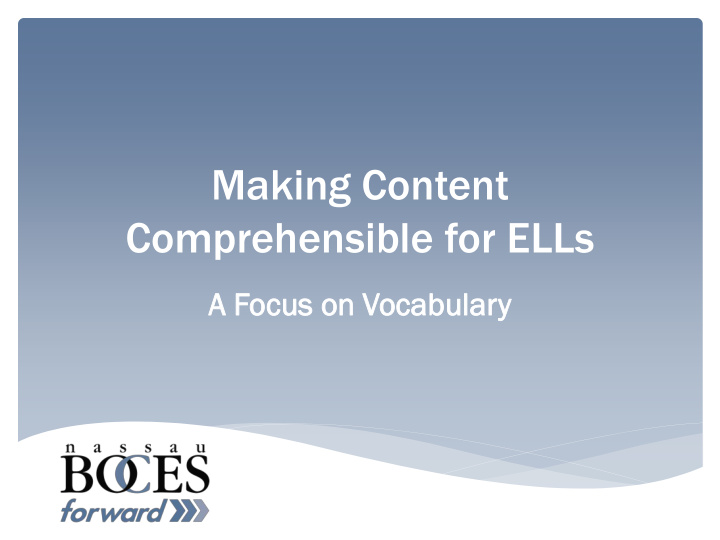



Making Content Comprehensible for ELLs A Focus cus on Voca cabula bulary
Front-loaded Words Words s that at can be taught ght apart t from m the lesson son context Appropria opriate e for inst struction ruction during ing engagem gement nt activ ivities ities 2
Lesson-embedded Words Suit itab able le for teaching hing during ing conten ent t inst struction ruction Reading ding from m text xt Pa Partici ticipat pating ing in an activit ivity Condu ducting cting an experime periment nt List stenin ning g to a lecture ture Writing ting for an assignmen signment 3
Blended Words Introdu oduce ced d during ing front-loadi ading ng Common definitions Examples from prior knowledge Revisi isited ed and refined ined Scientific definitions 4
6 Steps for Teaching Vocabulary 1. Identi 1. ntify y Words s All Stude udent nts s Need to Know Identify the key words for the lesson Indicate if the words are to be front-loaded, embedded or blended 2. Identif 2. ntify y Words ds ELLs Ls Need to Know Search for other words in the lesson that ELLs do not likely know Add these words to the three categories 5
6 Steps for Teaching Vocabulary 3. Select 3. ect the Highest ghest-Pri Priority ority Words ds Words that are essential to understanding the lesson Words that are key words used in many content lessons Do not substitute for more common words 4. Choose 4. ose 10 Words s (or r fewer) r) per lesso sson Set a limit Front-load when possible 6
6 Steps for Teaching Vocabulary 5. 5. Buil ild d From m Informa ormal l to Formal al Un Underst stan anding ding Activate prior knowledge or experience Point out context clues 6. 6. Plan Many Op Opportu tunities nities to Apply y Key Words Reuse key words and emphasize them during teacher talk Have key words readily available on word charts; word walls; in notebooks; or in personal glossaries 7
Tips for Teaching Vocabulary Words Routinize tinize Instr tructional ctional Steps eps Follow a set routine so students can focus on the vocabulary and not be concerned with the teaching steps Use Suppor portiv tive Visu suals als Incorporate visuals such as realia, photos, clip art and graphic organizers to “show” the word as you present it 8
Tips for Teaching Vocabulary Words Teach h Word Pa Parts ts Point out common elements among certain words Roots Prefixes Suffixes Apply y Key Words s Repeat eated edly ly Create opportunities for students to practice new words in structured and unstructured situations 9
Tips for Teaching Vocabulary Words Obser erve e and Assess sess Observe students’ use of key words orally and in writing Include key words in your summative and formative assessments 10
Word Wall, Glossary Rati tionale: nale: Students dents need to have impor orta tant nt vocabular ulary words ds readily dily available able to use when they y speak ak and writ ite e about t their ir ideas. s. 11
12
13
Sentence Frames Rati tionale: nale: ELLs Ls need a star arting ting place e for speaking aking and writ iting ing their ir ideas. as. Frames ames also o provide ide models els of correct rect constr truction, ction, gramm ammar ar and usage. ge. 14
Vocabulary Self-Rating Rati tionale: nale: Students dents need to know the key words ds they will l learn rn so they y can plan and monit itor or their ir learning. rning. 15
Concept Organizer Rati tionale: nale: Students dents should uld have an in depth th understand standing ing of the meaning ning or multi ltiple ple meaning nings s of select lected ed academic emic vocabular ulary. 16
17
18
Word Form Chart Rati tionale: nale: Students dents need to know the differen erent t forms ms of a key word so they can refer er to them m when engagi ging g in discus cussion ion or writing. ting. 19
20
List-Group-Label Rati tionale: nale: Organizing anizing words ds into o word families ilies and concept pt categories egories promo motes es schema ema format mation n and concept ptual ual understa standing. nding. 21
22
23
Features Matrix Rati tionale: nale: ELLs Ls need clarif rific ication ation on similar milar and freque uently ntly confused sed terms rms. . 24
When to Use Vocabulary Tools Tool Front-Load oad Embed ed Blend nd Review Word Wall, Glossary Sentence Frames Vocabulary Self-Rating Concept Organizer Word Form Chart List-Group- Label Features Matrix 25
www.nassauboces.org 26
Recommend
More recommend